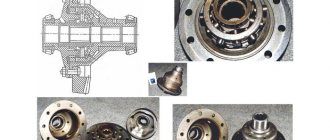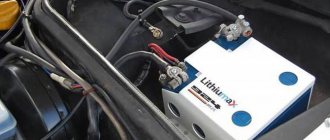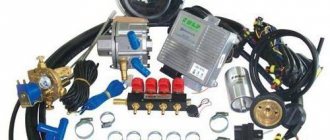Main types of heaters
All available equipment of this type is divided into two categories:
- liquid
- air
Liquid heaters are installed in close proximity to the engine and integrated into the main cooling system. Heaters of this type include the function of a pre-heater - they heat the coolant, which in turn increases the temperature of the engine and the air in the cabin. Quick warming up of the entire car is the main advantage of liquid heaters.
Air heaters are used exclusively to warm up the interior. They work autonomously and do not use motor power for their work. The efficient and economical operation of air heaters allows them to be used primarily for trucks, minibuses and other commercial vehicles.
In Russia, thanks to the climate and long distances, installing an autonomous heater on trucks is in great demand. Our company's specialists have accumulated extensive experience in providing this service. We can also select the most suitable equipment in terms of power and other characteristics, depending on the volume and configuration of the heating area.
Popular models of autonomous car heaters
We list the most popular devices, the operation of which requires connection to the on-board power supply:
- Planar 4D is an air-type heater that runs on diesel fuel. The 4 kW model allows you to regulate both the temperature and the speed of the air flow supplied to the cabin. Modification 4D-12, as the name suggests, is suitable for use in passenger cars, since it requires connection to a 12-volt battery. A more productive modification, Planar 4D-24, runs on 24-volt batteries and therefore can be used to heat buses and heavy trucks, as well as special equipment. Electricity consumption is at the level of 4 A/h, which is quite acceptable when using a battery with a capacity of 150 A/h. The cost of the heater is from 190,000 rubles;
- Webasto AIR TOP 02000ST is a series of popular air-type autonomous heaters from a well-known global manufacturer of automotive components. With a thermal power of 2 kW, these devices can operate on several types of fuel. It is possible to adjust the temperature and air flow speed. Electricity consumption, as in the previous case, is 4 A/h, so if used in a passenger car, it is recommended to install an additional battery with a capacity of 75 A/h. The average cost of heaters of this series is 450,000 rubles;
- Hydronic B04W SC is one of the few popular representatives of liquid-type heaters, which is often used as a pre-heater. It runs on gasoline, the thermal power of the device is 4 kW. During heater operation, this indicator can be adjusted in the range of 1.50-4.50 kW. Can be used on cars with a gasoline engine up to 2.0 liters. Electricity consumption depends on the level of generated power and averages 2-3 A/hour. That is, a battery with a capacity of 75 A/h will be drained in approximately 15 hours of continuous operation. The cost of the model starts at 32,000 rubles;
- Trumatic E02400 is an air-powered auxiliary heater powered by LNG and generating heat with a power of 2.5 kW. In this operating mode, gas consumption is 100 g/hour. An important advantage of the model is low energy consumption (about 2 A/hour). The obvious disadvantage is the complexity of installation. Can be used for heating both passenger cars and trucks. Costs about 100 thousand rubles.
We tried to include in our review the maximum number of varieties of autonomous heaters with a description of their main technical characteristics. Based on this data, you can decide which device will be most suitable in your case.
Installation of autonomous heaters Webasto and Eberspächer
The range of thermal equipment from German manufacturers is extremely wide. Installing a Webasto or Eberspächer air heater will provide heat to a cabin or interior of any size - from a compact passenger car to a large bus, and the heating power of the preheaters ranges from 4 to 35 kW, which allows you to choose the right model for any engine.
Working with Webasto and Eberspächer thermal equipment is especially convenient due to the availability of a whole range of remote control tools . You can control on-board heating devices not only from the cabin or interior of the car, where a special panel is located, but also from a remote control with a range of up to 1 kilometer, or via a mobile phone - using SMS or a special application. Installing a pre-heater with a GSM module makes it possible to select operating modes of the device even from a landline phone through the voice menu!
The minimum cost of installing a European-made heater in a car, including the price of the device itself, is about 50 thousand rubles. The increase in price is significantly influenced by increasing the power of the device and the connection of additional controls.
What is an autonomous heater and why is it needed?
This device is also called an air heater or a dry hair dryer; it is used to warm up the air in the passenger compartment or cabin of the car and further maintain the temperature for a given time. First of all, heaters are intended for vans, trucks, special equipment, buses, yachts, but can also be installed in passenger vehicles - minivans, SUVs.
Structurally, the device consists of elements (using the example of Webasto AirTop 2000):
- timer or thermostat;
- combustion chamber or "boiler";
- heat exchanger;
- air blower;
- burner (spray);
- dosing pump;
- filament pin;
- overheating and flame sensors;
- Control block.
The heater has its own exhaust system for removing combustion products and a muffler.
Advantages of using an autonomous air heater:
- elimination of insufficient heating of the interior and cabin with a standard stove;
- creating comfortable conditions in the cabin or cabin with the engine off, which is especially important for overnight stays during fishing, hunting, and traveling;
- reduction of time for heating the interior and cabin;
- defrosting glass and removing condensation;
- can be used as a fan to blow through the interior;
- saving battery power for heating compared to a pre-heater: to heat the cabin of a standard truck, an air heater will consume only 2 kW of energy, while a liquid pre-heater will require about 7–10 kW;
- efficient heating with low fuel consumption from 0.15 liters per hour (depending on power and dimensions).
Installation of autonomous heater Planar
For those vehicle owners who find installing a Webasto or Eberspächer heater too costly, our company is ready to offer similar heating equipment from a domestic manufacturer. Planar brand devices are perfectly suited for work in Russia and on Russian vehicles - it is no coincidence that many domestic manufacturers of trucks, truck cranes and other heavy equipment have chosen to install Planar autonomous heaters as a standard means for heating drivers’ work areas . These devices do not fail even at very low air temperatures - down to minus 45°! They are resistant to voltage fluctuations in the vehicle’s on-board network - the main cause of breakdowns of electrical appliances in vehicles with high mileage - and have a wide operating range:
- Models for 12 V on-board network – from 10.5 to 16 V.
- Models for 24 V on-board network – from 20.5 to 30 V.
When the voltage goes out of range, the device automatically turns off. Built-in automation also monitors fuel combustion (if combustion stops for some reason, the device turns off), heat exchanger overheating and many other system operating parameters.
With comparable thermal power, the cost of installing a Planar heater, including the cost of the equipment itself, is 40-60% lower than the price of equipping the machine with an imported system.
Operating principle of an air heater
The heater is installed in the cargo compartment, container or interior (cabin) of the car. The device is connected to the fuel tank and runs on liquid fuel - gasoline or diesel.
After activating the operation, the device pumps fuel liquid through its own system of channels from the main tank of the vehicle or an autonomous fuel tank into a special chamber, where air enrichment occurs and the fuel-air mixture is ignited. The released energy is transferred from the heat exchanger and the air blower to the cabin. The air intake is carried out both from the interior of the cabin or cabin and from the outside.
The air temperature and flow power are regulated using a thermostat or timer.
Who should you trust to install the heater?
On the Internet you can find a lot of advice on how to do it yourself, for example, installing a Planar air heater. Unfortunately, following instructions step by step without proper knowledge of theory and practical experience often leads to a negative result: the heating system does not fully perform its task.
is much more reliable to order the installation of interior or cabin heaters where the devices are purchased . Our company carries out installation of heating equipment and its further service at any time of the day, as agreed with the client.
Thanks to partnerships with manufacturers and the high qualifications of our specialists, we guarantee the optimal selection of the heating system model and installation of the heater in a car of any brand in the shortest possible time, in compliance with all requirements and with the execution of all documentation.
You can get advice from a specialist in installing heaters by phone or toll-free number.
Where to install an autonomous heater at an affordable price
Thanks to our own spare parts warehouses, the cost of our services is lower than in other service centers in Russia. Powerful technical bases give us the opportunity to install, repair and service autonomous heaters in different regions in the shortest possible time. Our specialists always take into account the features of commercial equipment and provide a guarantee for all types of services we provide. We will help you choose the optimal equipment to solve your business problems. Request a call back or ask your question in the online chat on this page. Our specialist will provide all the necessary information and help in solving your problem. Contact us right now!
Warm jacket: Additional heating systems in a car
The radiator itself is usually located under the seat. This is the most optimal place. You will also need to display the start button on the dashboard. The only drawback of such a system is increased noise. Also pay attention to the cost of such equipment; a normal stove for additional heating will cost a tidy sum.
Additional radiator
Despite some difficulty in performing such modifications, this is a popular option. This is explained by the low cost of such work; you only need an additional tube and another radiator. It is better to purchase a special radiator that can be installed under the seat without modifications. It also has a fan, which allows for more efficient heating of the interior.
- We fix the stove under the seat. There are several factors to consider. The first of them is the convenience of the driver and passengers. The radiator should not touch people's feet, otherwise burns may occur. The need to occasionally move the chair to ensure maximum comfort is also taken into account.
- Make sure that the stove does not interfere;
- Let's depressurize the cooling system. It is advisable to drain the antifreeze, but in principle, you can do without it. All the same, then you will have to pump the system, expelling the air;
- Connect the hoses going to the additional stove. This can be done in several places. In some models it is more convenient to connect to the system near the engine compartment, in others it is better to do this closer to the pump. To work you will need tees. Make sure that the hoses do not touch the engine or any moving parts;
- Drill 2 holes in the wall of the engine compartment. You will place the pipes in them. It is advisable to make the holes with a diameter of 19 mm;
- Lay the pipes, it is best to place them under the casing;
- Route the pipes near the heater. Now you need to connect them to the outputs of the stove. To do this, you need to use suitable hoses.
- Secure them with clamps;
- Fill with antifreeze. Please note that now you will need a little more of it. Typically the additional volume is 2 liters. Bleed the system to completely remove any air pockets.
Read more: Air conditioning or climate control in a car, apartment: what is the difference, differences, which is better?
Advantages of climate control over air conditioning in a car or apartment: description All work takes 4-5 hours. The only drawback of such a heater is that it takes longer to warm up the antifreeze to operating temperature. This is due to the increased volume and, accordingly, greater heat capacity.
Conclusion. In winter, not every car can boast of warmth in the cabin. Therefore, installing an additional stove in the car interior with your own hands is not uncommon. Please note that there are several ways to additionally heat the interior. Your task is to choose the most optimal option for your car.
The engines of trucks and ordinary cars and buses that are produced these days cannot produce the required amount of heat, especially in the cold season, to heat the entire interior. Thus, the conditions in the car bring discomfort and prevent the driver from concentrating on his business. Thanks to developments and innovations, the Planar battery can become an additional source of heat that is completely independent of engine operation.
What is good about an autonomous car interior heater?
Its main advantage is the possibility of use in any conditions and autonomy. Usually, a standard heater successfully copes with heating the interior of, for example, a truck. And everything looks normal when moving. But during an overnight stay in winter, the picture is no longer so rosy.
If we consider trucks, and usually such autonomous interior heaters are installed on them, then it is necessary to take into account that standard heating devices operate when the engine is running. If you spend the night on the road, this leads to unjustified fuel consumption and a decrease in engine life. In addition, there are other situations when an autonomous heater is simply necessary.
We are talking, for example, about a delivery vehicle that moves inside the city with frequent stops and short distances, when it simply does not have time to warm up sufficiently. And in minivans and buses, the power of the standard heater is not enough to warm up the interior. Not to mention that it is prohibited to spend the night in parking lots with the engine running.











